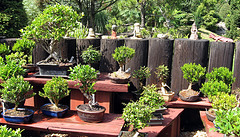
www.flickr.com/pitel
Interested in growing your very own bonsai? The initial step is to choose the right kind of plant.
Orange jasmine (also known as the China Box) is a large, multi-trunk shrub or small that belongs to the Rue or Rutaceae family. Its fragrant ‘orange blossom’ flowers stand out beautifully against the dark evergreen green leaves, which are made of anywhere from three to nine leaflets.
This evergreen shrub flowers at different intervals throughout the year, and produces fragrant, jasmine-scented flowers and striking, bright orange to reddish fruit. It makes for an excellent decorative container plant or a boxwood-like hedge because of its compact habit and dense glossy green foliage. It is generally propagated by seed.
Orange Jasmine, in fact, has many medicinal qualities. The Indians traditionally used its bark for making cosmetics, and the leaves as a stimulant and decongestant. The shrub’s astringent qualities have also been used to treat body aches, bleeding wounds, joint pain, and dysentery. In many regions of Asia, people chew the twigs as a natural toothbrush.
The plant is found from India and China, through south-east Asia, to Malaysia and northern Australia. It has an alluring scent for which it is cultivated in tropical and sub-tropical areas. It is named China-box because it can handle being trimmed. Often, it is used in hedges.
Orange jasmine is a hardy shrub that needs merely light to moderate watering. It is advised that you give it plant food every 20 to 30 days from early spring to mid-autumn, with a break of one month during the mid-summer. New growth requires to be pruned back to a few leaves, and after the new shoots have 6 or 7 leaves propagation can be done with seeds or cuttings.
This plant requires a pot that is glazed and not too shallow, and moderately fertile, well-drained soil that is free of nematodes. It needs protection from scales, white flies, sooty mold, and nematodes. Otherwise, it is a very hardy shrub and does not need much care.
Tagged with: growing bonsai • landscaping ideas
Filed under: Landscaping
